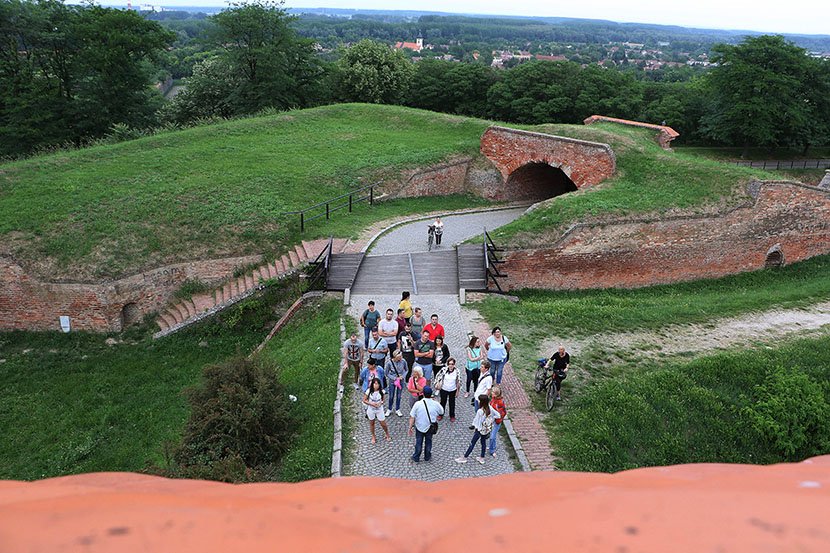Petrovaradin Fortress as a symbol of Novi Sad, Danube, and Vojvodina, and rarely anyone knows the terrible secret hidden behind its walls
You surely wondered while walking the fortress in Novi Sad, why are there so many cats on Petrovaradin fortress? They seem like guardians of the walls and tumultuous history while they are napping in the sun or watching the visitors while sneaking around.
And that's actually the truth. According to the legend, the cats preserved the Petrovaradin fortress that still proudly stands and testifies about some long and tumultuous times.
We all remember the story from a history class about the geese that saved Rome. The legend is connected with the start of the rise of Old Rome when the city was attacked by war thirsty Gauls. At the time the city had no walls, so the citizens retreated to one of Roman hills - Capitol, the only part of the city which was fortified and was inaccessible due to steep slopes.

One night, the Gals approached the Capital and they started climbing the slopes in silence. There was a temple of goddess Hera with hole geese in it. They started quacking and spreading their wings as soon as they felt unknown men approaching and they alerted the Roman guards. So, according to the legend, the geese saved Rome.
Many centuries later, on a rocky hill above the Danube, in today's Petrovaradin, just after winning against the military of Ottoman empire at Slankamen 1691, the Austrians started demolishing the old medieval fortress.
By building new ramparts and bastions, and in the absence of construction material, Austrian military engineers used stone and brickwork of the former Hungarian fortress of the 13th-century Cistercian monastery. One of the stone blocks that decorated the monastery church dedicated to Virgin Mary, with the representation of the cat's head, is included in the bastion of the Saint Inocentije.
Besides that, like in the epic folk song "Building of Rozafa Castle" where the sacrifices of animals are described by also building in of alive man into foundations to sustain the construction object, according to the legend, the builders of Petrovaradin fortress built in alive cats into foundations of new walls.

The legend says that, by sacrificing live cats, they will make the walls of the fortress better, but it was also believed that the cat has nine lives, so the fortress will last even longer, that it has nine lives as well.
And really, the Petrovaradin fortress resisted the Ottoman attack in 1694 and in 1716, prince Evgenije Savojski won one of the largest victories over Ottoman military.
The fortress remained unconquered during the Hungarian revolution. The emperor army under the command of Ban Josip Jelacic couldn't force the garrison to capitulate and to withdraw. After the first World War, when many fortifications of former Austro-Hungary were destroyed, Petrovaradin was spared once again because of the former Yugoslav Army colonel Dragos Djelosevic, and the story goes, "it was too beautiful to demolish it".

Before the end of World War II, the German army retreated across the Balkans, they crossed the Danube over the railroad bridge. A lot of explosives was placed in the railroad tunnel, which was right underneath the fortress. Thanks to the Italian war prisoner Gildo Pesapene who cut the wires and escaped, the tunnel wasn't mined, writes the magazine "Cat".
If the explosion occurred, there is no doubt that it would cause great demolition and damage on the objects above and the fortress. After the war, the fortress was proclaimed a Monument of History and most of it went under Civil Administration.
According to the tales that are confirmed by the old legends, the workers who worked on post-war reconstructions of the foundations of certain objects, they found mummified remains of the cats which turned to dust and ashes when they touched them.
Today, after countless centuries, wars and battles, the Petrovaradin fortress is being conquered by numerous tourists, artists, and musicians from all over the world, and the descendants of the pets of priests greet them on every step, offer them welcomes, but also remind of the vivid past of this magnificent fortress and one of the most important symbols of our turbulent history.

326. BIRTHDAY OF THE FORTRESS
On October 18, the Petrovaradin Fortress celebrated its 326th birthday.
The City Museum reminds that in the year 1692, after the great fights with the Turks that lasted from 1683, the Austrian army, under the command of Markgraf Ludwig Badenski, regained the ruinous medieval fortress Petrovaradin. The fortification and restoration began of the still important strategic location.
Based on the decision of the War Council to build a new fortress, according to the most modern rules of military architecture, the establishment and clearing of the terrain in the Upper Fortress began.
The foundation stone of the new fort was laid on October 18 in the presence of emperor's emissary, prince, and marshal Eugene Croy, at Leopold's bastion. That day was recorded as the beginning of the construction of the new Petrovaradin fortress, which lasted with interruptions until 1780.
The new fortress consisted of the Upper and Lower city, had high ramparts and was surrounded by water spouts. Petrovaradin Sanac on the opposite side of the Danube grew from a settlement into Novi Sad over the time.
VIDEO: History lives in places like Petrovaradin, and there are people who like to relive it over and over again
Video: Ambasada obeležila Dan nezavisnosti, prisustvovala Ana Brnabić i članovi Vlade
Telegraf.rs zadržava sva prava nad sadržajem. Za preuzimanje sadržaja pogledajte uputstva na stranici Uslovi korišćenja.

